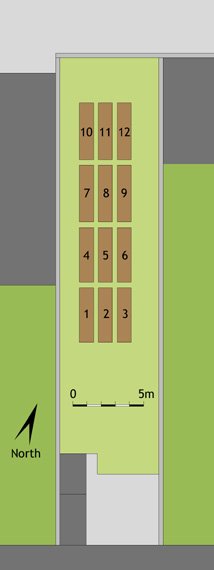We dug a pit almost 1 meter deep in order to examine the nature of the soil in the garden (or at least one section of it).
 The nature of the layers of the soil is an important factor in the productivity of the garden, as is the ratio of sand/silt/clay in each layer. Through digging we found 4 distinct layers of soil:
The nature of the layers of the soil is an important factor in the productivity of the garden, as is the ratio of sand/silt/clay in each layer. Through digging we found 4 distinct layers of soil:

About 30cm of topsoil containing a fair amount of stones.

About 40cm of soil that contained less stones and was lighter in colour.

A 20cm layer of rubble containing a lot of shells.

The subsoil started about 90cm down.
The soil in this back garden was probably brought in from elsewhere, being so close to the canal and as indicated by the presence of a shell and stone layer, and it is possible that if we kept digging we would find additional layers.
We took samples of the topsoil, mid-soil and sub-soil, removed all of the stones and roots did a fractional soil analysis test on each of the three samples. We also did the test on a sample of clay soil from Bruce's allotment. The test involved filling a jar half full of the soil, then filling it it up with water to within a few centimeters of the rim. Once the lids were sealed we shook up the jars vigorously for 5 minutes to break up all of the soil clumps and then placed them on the table.

The sand settled out of the mixture first, generally within a minute, then the silt settled over the next hour, and finally the smallest particles of clay settled out of the water over the next couple of days/weeks

This photo was taken after one hour of settling, and shows (from left to right) the sub-soil, the mid-soil, the topsoil and the soil from another site. It is difficult to see the layers of sediment with these photographs.

The sample of the topsoil settled fairy quickly and the water at the top became almost clear within the hour - indicating that there is almost no clay in the sample. It was difficult to locate the separation between sand and silt as it is such a gradual transition, but there seems to be about 60-70% silt and 30-40% sand.

The sample of soil taken below the topsoil is easier to read. Again the water became quite clear fairly quickly, and very little clay settled out - (a thin lighter line of clay is visible on top of the silt). In the photograph above, there is a red line drawn on the tape indicating the approximate division between sand on the bottom and silt on the top, with about 60% silt and 40% sand.

This sample is of the subsoil again shows almost no clay (the water is fairly clear after one hour) and only about 25% sand as seen by the faint red line.
This soil would be classified as a silt-loam with a medium texture. This soil is fairly free draining, but may not be capable of holding on to nutrients because of the lack of clay and soil humus, both of which operates almost like a magnet to attract and hold onto nutrients.

In comparison, with the soil sample taken from the clay topsoil of Bruce's allotment, it is impossible to see any layering of the soil, and it will end up taking a week or more before the clay settles out of the water. This sample eventually showed over 50% clay with about 25% each of silt and fine sand. This soil is fairly fertile but difficult to manage.
 In the temperature charts above (extracted from the Met Éireann summary) the maximum temperature for Dublin area (blue line) dropped considerably from the 18th to the 21st when all of the precipitation was snow or hail, and there was ground frosts at night throughout the month.
In the temperature charts above (extracted from the Met Éireann summary) the maximum temperature for Dublin area (blue line) dropped considerably from the 18th to the 21st when all of the precipitation was snow or hail, and there was ground frosts at night throughout the month. These charts show how little rain came in the latter part of the month and that we only had 4 days where there was more than a light drizzle of rain (blue bars), not enough to really soak into the ground.
These charts show how little rain came in the latter part of the month and that we only had 4 days where there was more than a light drizzle of rain (blue bars), not enough to really soak into the ground.










